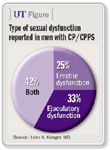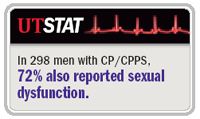Article
Sexual dysfunctions common in CP/CPPS patients
Sexual dysfunction is common in patients with chronic prostatitis/chronic pelvic pain syndrome (CP/CPPS), regardless of the type of CP/CPPS they have.

Key Points

That was the conclusion of two studies presented here at the 2007 AUA annual meeting. Although the rates of sexual dysfunction in these patients need to be compared with those of healthy men in a controlled study and compared with rates before patients developed CP/CPPS symptoms, the studies show that these patients need urologists' help in treating their sexual dysfunction.
One particular study lends support to the idea that distinguishing between "inflammatory" and "noninflammatory" prostatitis isn't useful clinically.
Men with sexual dysfunction had worse CP/CPPS symptoms, with a total NIH-Chronic Prostatitis Symptom Index (CPSI) score averaging 22.4+6.9 (vs. 20.4+7.8; p=.027), and worse quality of life scores, with an average subscore of 8.5+2.7 (vs. 7.7+2.7; p=.01) than did patients who did not have sexual dysfunction.
Men with both erectile and ejaculatory dysfunction experienced worse CP/ CPPS symptoms, with a statistically significant difference in their total (p=.042) and QoL CPSI score (p=.006).

In a similar study of 134 men with CP/CPPS from Justus Liebig University in Giessen, Germany, 35 were identified as having type IIIA (inflammatory) prostatitis and 99 were identified as having type IIIB (non-inflammatory) prostatitis. Among all participants, 63 (47%) had erectile dysfunction on the basis of an IIEF score of 25 or more. Seven men had no sexual activity. The dysfunction typically was rated as moderate in 46% (26) of patients, although 25% (14) had severe dysfunction, 11% (six) had mild to moderate dysfunction, and 18% (10) had mild dysfunction, reported the authors, led by Wolfgang Weidner, MD.
Among the men with type IIIA prostatitis, 15 (24%) had erectile dysfunction, and among those with type IIIB prostatitis, 48 (76%) had erectile dysfunction. The distribution of severity of erectile dysfunction did not show a statistically significant difference.
Data shape clinical practice
Do the results pertain to men in North America? Probably.

Newsletter
Stay current with the latest urology news and practice-changing insights — sign up now for the essential updates every urologist needs.















